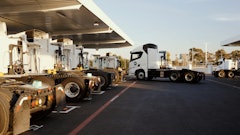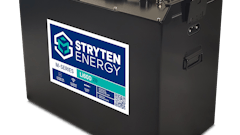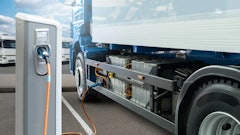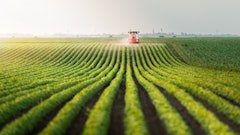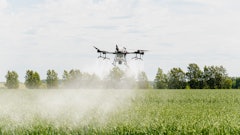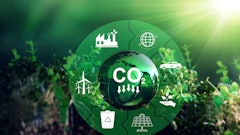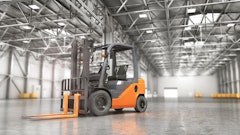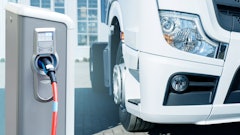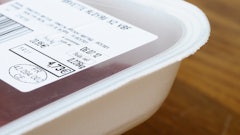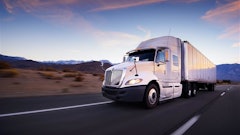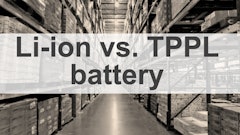
and completed in 2009.
...towards reducing your carbon footprint. In an exclusive interview, APL’s Gary Griffith offers other ways to achieve environmental sustainability.
Henry Ford once reportedly said that a customer could choose any color for his car that he wanted “so as long as it was black.”
Today’s logistics professionals can surely relate, although their color of choice is decidedly brighter.
“There are a lot of things a well-functioning distribution center in this day and age needs to do,” says Gary Griffith, an executive director at warehousing and supply chain company APL Logistics, Oakland, CA. “But one of the foremost is to be green and support its company’s efforts to reduce its carbon footprint.”
As concerns about global warming gain momentum—and more logistics professionals participate in voluntary environmental initiatives—Food Logistics sat down with Griffith to get his perspective on how companies can use a wide variety of warehouse and other supply chain design principles to make sustainability work for them.
When you hear the terms “sustainability” and “facility design,” what’s the first thing that comes to mind?
Site selection. Freight movement typically accounts for far more of a company’s carbon footprint than warehousing. As a result, the most important green warehouse design initiative a company can undertake is often network optimization.
So when it comes to being green, many of the classic rules of supply chain management still apply?
Effective warehousing has always been closely related to strategic site selection. And green warehousing is often no different. If you want a location to help reduce your organization’s carbon footprint as much as possible, then transportation efficiency, flexibility and accessibility are paramount.
That said, there’s a lot of emphasis on the LEED rating system, which is predominantly a facility design issue.
LEED is a great initiative, and it’s clearly become the standard for sustainable industrial construction. One thing that particularly impresses me is how multifaceted it is both in terms of the levels of recognition that facilities can achieve—certified, silver, gold and platinum—and the variety of categories in which they can earn the necessary points for each level. It sends a clear message to the industry that there’s more than one route to achieving sustainability and smaller carbon footprints. And that’s a message all of us can get behind.
Many of LEED’s initiatives focus on new construction or remodels. But with warehousing starts in decline and many companies trying to do what they can not to undertake any costly new initiatives such as construction/renovation, how can companies achieve the smaller carbon footprint they desire?
One option is to participate in LEED for Existing Buildings: Operations & Maintenance. Like the other LEED certification systems, this initiative does involve making the physical aspects of a building and its equipment greener. However it also focuses on the processes that take place in and around a facility—all of which can also significantly impact a company’s carbon footprint.
Another option is to work with carriers or 3PLs who participate in other green logistics initiatives such as SmartWay. Like LEED, its many participating companies have made strides in reducing the supply chain industry’s energy consumption, so in working with these organizations, a company can say it’s part of the green solution.
And of course, companies can always emulate LEED best practices without formally pursuing certification. In fact, if a company has made any green improvements to its distribution centers in the past few years, it’s been doing this already—even if it didn’t think of its improvements in those terms.
Can you provide some examples?
If a company has re-roofed a distribution center or DC parking lot with lighter-colored materials—or even to put something such as grass on the roof—it’s significantly reduced that facility’s heat island effect. If it’s changed to more modern lighting technologies, it may have reduced its light-related electricity requirements by as much as 70 percent.
And if ongoing drought conditions have inspired it to seek out new landscaping options that make better use of things like storm water, it’s probably dramatically lowered its water consumption.
These activities are exactly the kinds of things that LEED validators look for during a facility certification process. And as an added bonus, they’re often the kinds of things that CFOs and accounting departments love, because many of them wind up being money-savers, too.
That’s a perfect segue to our next question: Are greener warehouse design practices more expensive?
The jury’s divided. Some experts say that green materials are 5 to 7 percent more expensive. Others say these materials are comparably priced. But most of them agree that many green investments usually pay for themselves fairly quickly.
Thankfully many green warehousing initiatives wind up being both sustainable and cost-effective, because their emphasis is on minimizing waste and improving efficiency. So it’s a win-win for everyone.
Consider the effect of installing skylights in a facility. Not only does this allow companies to use fewer artificial lights and reduce ongoing electricity consumption in a DC, it also tends to create a more pleasant work environment. Even small window installations can result in huge lighting and morale improvements.
Or think about forklifts. They may not log as many miles as trucks or trains. But they still cover a fair amount of ground each year, and some of that ground is probably highly unnecessary. Simply shortening the journey between a facility’s most popular products’ storage slots and the loading dock via a product slotting optimization can significantly reduce a company’s forklift energy requirements—and ultimately its overall expense.
On a broader scale, if a company has given its DC personnel Lean training, the chances are good that some of the money-saving projects they’ve implemented are related to better energy use. Our company’s warehousing line of business launched a Lean initiative a couple of years ago, and while all of the nearly $8 million we’ve saved can’t be tied to carbon footprint reductions, many of them can.
The green-equals-saving-more-money formula is true on the transportation side of the equation, too. For example, ocean transportation is both up to 96 percent greener and at least 75 percent less expensive than air. And not only can an intermodal move cut fuel use and greenhouse gas production by as much as 65 percent on moves greater than 1,000 miles, it’s also less expensive.
One more green question: Assuming that they have some money to invest in greening their facilities, what are some other brick-and-mortar improvements companies might consider?
One idea is to install facility dock doors that open and close more quickly—or doors that have higher levels on insulation—because both can dramatically reduce a DC’s temperature loss. And (although it’s not a brick-and-mortar improvement) companies should consider investing in better advanced scheduling software programs to reduce the amount of times trucks have to wait—while idling their engines—for a dock door to open up.
What’s your take on some of the other current hot buttons that businesses can’t afford to ignore?
Globalization is one of the biggest forces at work both from a network design and facility layout perspective. Facilities’ proximity to ports and a wide variety of transportation alternatives has become increasingly important. And warehouses that can offer transloading and other deconsolidation services are becoming increasingly valuable commodities. Granted, this issue isn’t as significant in the food industry as it is in others. But it still bears mentioning, because it could affect food companies’ access to the best facilities in certain areas.
False Claims Of Sustainable Best Practices Are Rising
“Greenwashing,” or false claims of sustainable business practices, is on the rise. The U.S. Green Building Council’s (USGBC) Leadership in Energy and Environmental Design (LEED) certification is a useful measure to evaluate whether a facility is truly “green.”
Below are 10 key LEED characteristics that most—if not all—green facilities have in common:
• Materials used to construct the building are manufactured and obtained within a radius of 500 miles and primarily consist of recycled material such as steel.
• During construction, the majority of waste is recycled.
• Exterior lighting is minimized, reducing light pollution.
• The building’s roof is white (reflecting more heat than it absorbs).
• Premium efficiency electric motors are specified.
• Once the building is substantially complete, all equipment is commissioned to ensure performance is in accordance with specifications.
• Materials emitting only low amounts of volatile organic compounds are specified (for example, floor coverings, paint, adhesives, etc.).
• A maximum amount of windows provide daylight and external views for employees.
• Low-flow plumbing fixtures, such as toilets and sinks, are used.
• The building’s landscaping features plants that require very little water.
According to the USGBC, buildings account for 72 percent of electricity consumption, 39 percent of energy use and 38 percent of all carbon dioxide (CO2) emissions. By incorporating several of these practices, food logistics companies can truthfully decrease their environmental impact, while improving the bottom line.—Jayme Wu
Wu is a LEED-accredited professional and engineer with Stellar, an international design, engineering, construction and mechanical services firm based in Jacksonville, FL.




